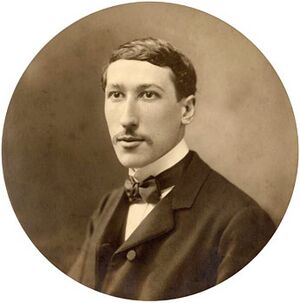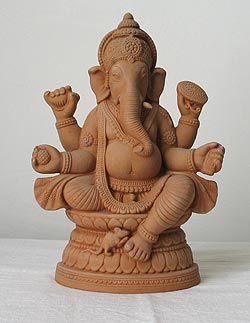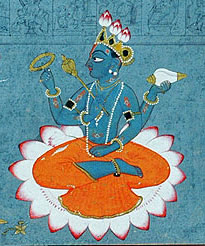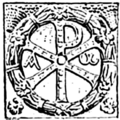René Guénon facts for kids
Quick facts for kids
René Guénon (Abdalwahid Yahia)
|
|
|---|---|

Portrait from 1925
|
|
| Born |
René-Jean-Marie-Joseph Guénon
15 November 1886 |
| Died | 7 January 1951 (aged 64) |
| Era | 20th-century philosophy |
| Region |
|
| School |
|
|
Main interests
|
|
|
Notable ideas
|
|
| Signature | |
 |
|
René Guénon (born November 15, 1886 – died January 7, 1951) was a French writer and thinker. He was also known as Abdalwahid Yahia after he became a Muslim. He wrote a lot about deep ideas like metaphysics, which is about the basic nature of reality. He also explored esotericism, which means hidden spiritual knowledge, and the meaning of symbols.
Guénon wanted to share ancient Eastern wisdom with Western readers. He believed these teachings were universal and could help people understand the world better. He joined a spiritual path called Sufism (a part of Islam) when he was 24. His books have been translated into more than twenty languages.
Who was René Guénon?
Early Life and Education
René Guénon was born in 1886 in Blois, a town in central France. His family was Roman Catholic, and his father was an architect. He was very close to his mother and aunt, who taught him to read and write.
In 1904, Guénon moved to Paris to study. He focused on math and philosophy. He was a very smart student, especially in math, even though he had poor health. Because of his health, he stopped preparing for tough university entrance exams in 1905.
Exploring Spiritual Groups
In Paris, Guénon became interested in different spiritual groups. He joined some groups that studied Esoteric Christianity and Gnosticism. However, he soon felt that many of these groups didn't have true spiritual teachings.
He started writing for a magazine called La Gnose (meaning "Gnosis"). In this magazine, he wrote about Eastern spiritual traditions like Taoism, Hinduism, and Sufism.
Guénon also joined a Masonic lodge in France. He hoped to find true spiritual paths there. Later, he felt that many Masonic groups had lost their original spiritual purpose.
Teaching and Writing Career
Because of his health, Guénon didn't have to serve in the military. He used this time to study philosophy at the Sorbonne during World War I. In 1917, he taught philosophy in Sétif, Algeria, for a year.
After the war, he stopped teaching to focus on writing. His first book, Introduction to the Study of the Hindu Doctrines, came out in 1921. This book helped him become well-known in Paris.
From 1925, Guénon wrote for a magazine called Le Voile d'Isis ("The Veil of Isis"). Later, this magazine changed its name to Les Études Traditionnelles ("Traditional Studies") because of Guénon's influence.
Moving to Egypt
In 1930, Guénon moved to Cairo, Egypt. There, he became more deeply involved in Sufism, a mystical branch of Islam. He took the name "Abd al-Wāḥid Yaḥiā." He lived in the old parts of Cairo and often visited al-Azhar University, a famous center for Islamic learning.
In 1934, Guénon married the youngest daughter of a lawyer he met in Cairo. They had four children. In 1937, they moved into a small villa. Guénon mostly stayed at home, working, praying, and talking with close friends.
He became an Egyptian citizen in 1949. René Guénon passed away on January 7, 1951, at the age of 64. His last word was "Allah" (God in Arabic).
What did René Guénon write about?
René Guénon's writings cover several main topics:
- Understanding Metaphysics: He explained basic ideas about reality, like the meaning of "Tradition" (always with a capital T for him). Books like Introduction to the Study of the Hindu Doctrines and Man and His Becoming According to the Vedanta are examples.
- Initiation and Spiritual Paths: He wrote about how people can gain spiritual knowledge through a process called Initiation. This is a special way of receiving spiritual influence from a teacher. His books Perspectives on Initiation and Initiation and Spiritual Realisation explore this.
- The Meaning of Symbols: Guénon believed that symbols are a very important language. They can connect different levels of reality. Many of his articles on symbols were put together in the book Symbols of Sacred Science.
- Critiquing the Modern World: He often wrote about what he saw as problems with modern society. He felt that the modern world had lost touch with ancient wisdom. Books like The Crisis of the Modern World and The Reign of Quantity and the Signs of the Times discuss these ideas.
Key Ideas in His Books
Guénon used many words in a very specific way. He felt that words like "metaphysics" and "initiation" had lost their true meaning over time. He wanted to bring back their original, deeper sense.
What is Metaphysics?
For Guénon, metaphysics means what is "beyond physics" or beyond nature. It's about understanding reality that goes beyond what we can see or touch. It's a kind of "supra-rational" knowledge, meaning it's higher than just logical thinking.
He explained that to reach this knowledge, you need to study traditional teachings and practice "concentration." The spiritual journey has different stages:
- Reaching a "primordial state" where you are free from time. This is like the "lesser mysteries."
- Moving to "supra-human states" beyond normal human limits.
- Finally, reaching an "absolutely unconditioned state," which is the ultimate goal, called "Deliverance" (Moksha in Hindu teachings). This is like the "greater mysteries."
Understanding The Symbolism of the Cross

In his book The Symbolism of the Cross, Guénon explains a symbol found in almost all ancient traditions: the cross. He says it's not just a Christian symbol. The cross represents how a person can become a "Universal Man" by connecting all parts of their being.
He also talked about the difference between synthesis and syncretism. Syncretism is just mixing different ideas without truly understanding them. Synthesis, however, means seeing how different traditions come from one single, deeper truth.
The Multiple States of Being

In The Multiple States of Being, Guénon expands on the idea that there are many different states of existence, not just the one we experience. He talks about "metaphysical Infinity," which means something that has absolutely no limits.
He also discusses "Being" and "Non-Being." "Being" is the source of all that is manifested (everything that exists). "Non-Being" is what is beyond "Being," and it's not "nothingness" but something that cannot be described. This idea is linked to the "Unicity of Existence" found in Islamic teachings.
The Importance of Initiation

Guénon believed that true spiritual knowledge comes through initiation. This is a special process where a spiritual teacher passes on a "spiritual influence" to a student. He said you can't just learn this from books or by yourself.
He also explained that initiation is different from "mysticism." Mysticism is a more passive experience, while initiation is an active, guided path to spiritual realization.
Guénon thought that many Western spiritual groups had lost their true initiatory paths. He believed that some groups like Freemasonry still held parts of these traditions, but they needed to be revived.
Symbolism and Ancient Wisdom

For Guénon, symbolism is a very high form of language. It helps people understand parts of reality that ordinary words can't describe. He believed that the wise people in the East never lost this understanding of symbols.
He wrote a lot about different traditional symbols, like the "Center of the World" or the "axial symbols" (symbols related to a central axis). He believed that similar symbols found in different cultures, even far apart in time or place, point to a common, ancient source of wisdom called the "primordial Tradition."
Critiques of Modern Spiritual Movements
Guénon was very critical of groups like the Theosophical Society and the Spiritist movement. He wrote books like Theosophy: History of a Pseudo-Religion and The Spiritist Fallacy to explain why he thought they were misleading.
He believed these groups often mixed different ideas without true understanding (syncretism). He also felt they misunderstood Eastern teachings and focused too much on psychic phenomena instead of true spiritual development. He saw them as "anti-traditional" because they moved away from authentic ancient wisdom.
Images for kids
-
The circular snake of the Ouroboros is a symbol of Anima Mundi.
-
Devanagari Aum.
See also
 In Spanish: René Guénon para niños
In Spanish: René Guénon para niños
- Traditionalist School
- Western esotericism











